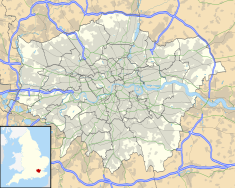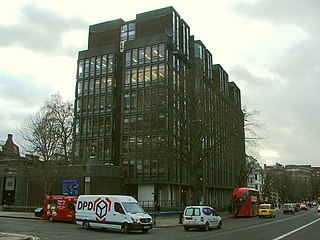
The Royal College of Art (RCA) is a public research university in London, United Kingdom, with campuses in South Kensington, Battersea and White City. It is the only entirely postgraduate art and design university in the United Kingdom. It offers postgraduate degrees in art and design to students from over 60 countries.
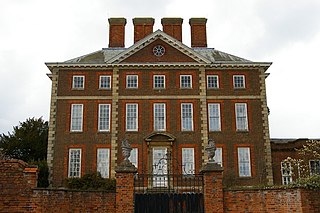
The Queen Anne style of British architecture refers to either the English Baroque architecture of the time of Queen Anne or the British Queen Anne Revival form that became popular during the last quarter of the 19th century and the early decades of the 20th century. In other English-speaking parts of the world, New World Queen Anne Revival architecture embodies entirely different styles.

Holland Park is an area of Kensington, on the western edge of Central London, that contains a street and public park of the same name. It has no official boundaries but is roughly bounded by Kensington High Street to the south, Holland Road to the west, Holland Park Avenue to the north, and Kensington Church Street to the east. Adjacent districts are Notting Hill to the north, Earl's Court to the south, and Shepherd's Bush to the northwest.
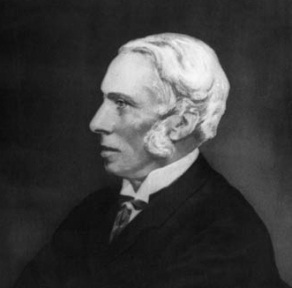
Richard Norman Shaw RA, also known as Norman Shaw, was a British architect who worked from the 1870s to the 1900s, known for his country houses and for commercial buildings. He is considered to be among the greatest of British architects; his influence on architectural style was strongest in the 1880s and 1890s.
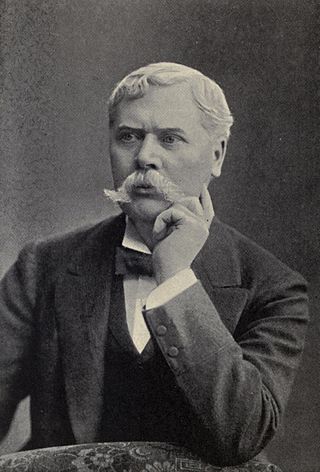
Marcus Stone was an English painter. Stone was born in London, and was educated at the Royal Academy.
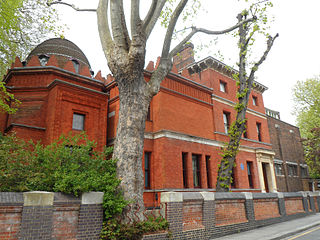
The Leighton House Museum is an art museum and historic house in the Holland Park area of the Royal Borough of Kensington and Chelsea in west London.

Sir Samuel Luke Fildes was a British painter and illustrator born in Liverpool and trained at the South Kensington and Royal Academy Schools. He was the grandson of the political activist Mary Fildes.

The Tower House, 29 Melbury Road, is a late-Victorian townhouse in the Holland Park district of Kensington and Chelsea, London, built by the architect and designer William Burges as his home. Designed between 1875 and 1881, in the French Gothic Revival style, it was described by the architectural historian J. Mordaunt Crook as "the most complete example of a medieval secular interior produced by the Gothic Revival, and the last". The house is built of red brick, with Bath stone dressings and green roof slates from Cumbria, and has a distinctive cylindrical tower and conical roof. The ground floor contains a drawing room, a dining room and a library, while the first floor has two bedrooms and an armoury. Its exterior and the interior echo elements of Burges's earlier work, particularly Park House in Cardiff and Castell Coch. It was designated a Grade I listed building in 1949.
Alexander Ethan Tudor-Hart was a British medical doctor in South Wales who was active in the Communist Party of Great Britain. He was the great grandson of American merchant Frederic Tudor and father of Dr Julian Tudor-Hart.

Little Holland House was the dower house of Holland House in the parish of Kensington, Middlesex, England. It was situated at the end of Nightingale Lane, now the back entrance to Holland Park and was demolished when Melbury Road was made. Number 14 Melbury Road marks its approximate location.
The Holland Park Circle was an informal group of 19th-century artists based in the Holland Park district of West London, England, especially in Melbury Road and Holland Park Road. George Frederick Watts, Frederic Leighton, Valentine Prinsep, Luke Fildes, Hamo Thornycroft and William Burges are considered key members of the group.
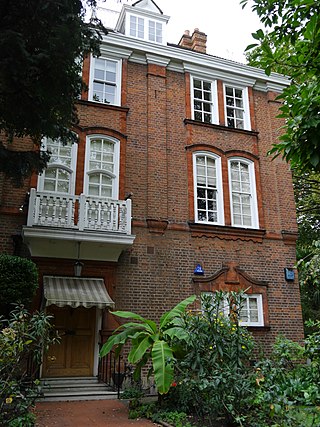
Woodland House is a large detached house at 31 Melbury Road in the Holland Park district of Kensington and Chelsea, West London, England. Built from 1875 to 1877 in the Queen Anne style by the architect Richard Norman Shaw, it is a Grade II* listed building. Commissioned by the painter Luke Fildes, Woodland House is next to William Burges's Grade I listed Tower House.

Henry Woods was a British painter and illustrator, and one of the leading Neo-Venetian school artists.
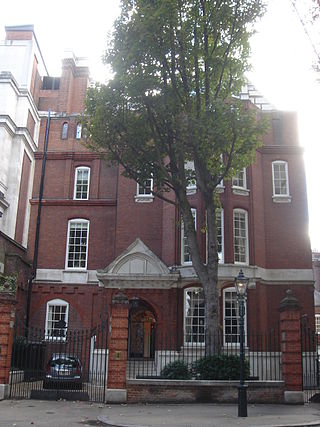
1 Palace Green is a Grade II* listed house on Palace Green, Kensington, London, England. It was built by Arts and Crafts architect Philip Webb, completed in 1870 with additions in 1874, and decorated by Morris, Marshall, Faulkner & Company.
Thomas Simpson (1825–1908) was a British architect associated with the seaside town of Brighton. As architect to the Brighton and Preston School Board and the equivalent institution in neighbouring Hove, he designed "a distinguished group of board schools" during the late 19th century, when the provision of mass education was greatly extended. Many of these schools survive and some have listed status. He also worked on five Nonconformist chapels for various Christian denominations, using a wide variety of materials and architectural styles. He was the father of Sir John William Simpson and Gilbert Murray Simpson, who both became architects.

St Michael and All Angels is a Grade II* listed Church of England parish church in Bedford Park, Chiswick. It was designed by the architect Norman Shaw, who built some of the houses in that area. The church was consecrated in 1880. It is constructed in what has been described both as British Queen Anne Revival style and as Perpendicular Gothic style modified with English domestic features. Its services are Anglo-Catholic.

Mells War Memorial is a First World War memorial by Sir Edwin Lutyens in the village of Mells in the Mendip Hills of Somerset, south-western England. Unveiled in 1921, the memorial is one of multiple buildings and structures Lutyens designed in Mells. His friendship with two prominent families in the area, the Horners and the Asquiths, led to a series of commissions; among his other works in the village are memorials to two sons—one from each family—killed in the war. Lutyens toured the village with local dignitaries in search of a suitable site for the war memorial, after which he was prompted to remark "all their young men were killed".

Colin Hunter was a Scottish artist of the Victorian era. Most of his works are seascapes.

The architecture of Bedford Park in Chiswick, West London, is characterised largely by Queen Anne Revival style, meaning an eclectic mixture of English and Flemish house styles from the 17th and 18th centuries, with elements of many other styles featuring in some of the buildings.

Melbury Road is a residential road in the Holland Park area of the Royal Borough of Kensington and Chelsea, London, England. It is known for houses owned by the Victorian Holland Park Circle, an informal group of 19th-century artists, including William Burges, Luke Fildes, Frederic Leighton, Valentine Prinsep, Hamo Thornycroft, and George Frederick Watts.

